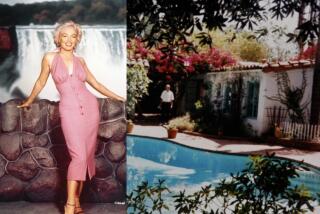The Long, Winding Road : Criticism Delays Mulholland Drive Scenic Plan
After 65 years of consideration, 17 years of study and 18 hours of public debate, Los Angeles city planners were within minutes Thursday of declaring Mulholland Drive a scenic parkway.
But planning commissioners stopped short after angry property owners warned that the whole idea may be illegal. Commissioners said they will have city lawyers review the parkway plan. They indicated that if it is cleared by lawyers, the commission will recommend approval.
The landowners charged that development controls proposed by the city to preserve views along the roadway violate a 1987 U.S. Supreme Court ruling. That ruling narrowed the ability of local governments to control development of private property.
The restrictions, which include a 45-foot height limit on new buildings, limitations on grading and bans on gaudy house colors and bright lights, are viewed by city planners and environmentalists as important to the proposal.
The controls would affect land a half mile on either side of 22-mile-long Mulholland Drive, which serves as the dividing line between the San Fernando Valley and the Westside. The famous roadway, which is only partially paved, was first conceived in 1913 as a scenic route by city water pioneer William Mulholland.
The proposal requires approval by the City Council. The basic ideas sprang from recommendations made by a citizens committee that has been studying Mulholland Drive since 1972.
Most of the about 200 people who jammed the Van Nuys Women’s Club called the restrictions too harsh. Many were also angered by proposals to construct new scenic overlooks that they fear will attract vandals.
Fight to Supreme Court
Property owner John Devonshire of Los Angeles likened the proposed controls to the theft of land by the city. He predicted that residents would fight to the U.S. Supreme Court and win.
“If you want our property, then pay for it. Until then, hands off or we’ll chop them off,” Devonshire said as the crowd cheered.
“Jeopardy” television game show host Alex Trebek told planners that he lives in a Mulholland home above Studio City that is painted white--a color discouraged by the proposed ordinance.
Trebek said he and most of his neighbors favor the “overall ambitions and aims” of the proposal. However, he urged redesign of the plan to reflect the varying housing densities along the roadway.
“This thing stretches 22 miles and it is difficult to come up with a plan that deals with the needs and fears of people living in such a long corridor,” Trebek said.
Supporters of the parkway designation said they like the parkway concept just the way it is, however.
“Without this plan, ridges will be lost, the road will be widened and schlock development will occur,” said Laura Lake, of a slow-growth group called Not Yet New York.
Mindy Mann, leader of a Benedict Canyon homeowners association, said the preservation effort also has her group’s support. “As we all know, God does not make mountains anymore. Without this plan, Mulholland Drive could become just another unprotected city street,” she said.
Commissioners said staff members will make final changes to the plan while lawyers study it.
“Is it a taking of land? “ asked Commissioner Theodore Stein Jr. “That’s a question, not a statement. I don’t think it is.”
The Supreme Court ruling cited by parkway opponents overturned a state Supreme Court ruling that had protected local governments from being sued by unhappy landowners or developers who had been restricted from developing their property.
The case involved the First English Evangelical Lutheran Church in Glendale. The church sued after being prohibited by Los Angeles County from rebuilding church property washed away in a flood. County officials banned the construction on grounds that the site was in a flood plain.
More to Read
Sign up for Essential California
The most important California stories and recommendations in your inbox every morning.
You may occasionally receive promotional content from the Los Angeles Times.











